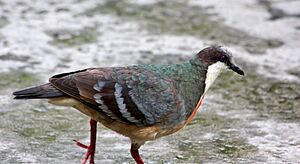Mindanao bleeding-heart facts for kids
Quick facts for kids Mindanao bleeding-heart |
|
|---|---|
 |
|
 |
|
| Conservation status | |
| Scientific classification | |
| Genus: |
Gallicolumba
|
| Species: |
crinigera
|
| Synonyms | |
|
|
The Mindanao bleeding-heart is a special type of bird. It is part of the pigeon family. This bird is also called the Bartlett's bleeding heart dove. It gets its name from a bright red spot on its chest. This spot looks a bit like a drop of blood.
This unique bird lives only in the Philippines. You can find it on islands like Mindanao, Basilan, Samar, Leyte, and Bohol. Its scientific name is Gallicolumba crinigera. The name Gallicolumba comes from Latin words. Gallus means "chicken" and columba means "pigeon."
Contents
What Does the Mindanao Bleeding-Heart Look Like?
The Mindanao bleeding-heart is about 29 centimeters (11 inches) long. It weighs around 184 to 204 grams. That's about as much as a small can of soda.
Its head and neck are a shiny metallic green. Its back is a chocolate brown color. The tail feathers are a purplish brown. The chin and throat are white. The most striking feature is the blood-red patch on its chest. Below this red patch, its feathers are a rusty orange. This color is darkest on its sides and lightest on its belly.
Both male and female birds look very similar. Young birds are a darker chestnut or reddish-brown. They have some metallic shine on their back feathers.
Different Types of Mindanao Bleeding-Hearts
There are three main types, or subspecies, of the Mindanao bleeding-heart:
- Gallicolumba crinigera cringera: This type lives on Mindanao, Basilan, and Dinagat Islands. It has a white throat and upper chest. The lower chest is light brown.
- Gallicolumba crinigera bartletti: This type is found on Basilan. It is smaller than the others. It also has a finer, more delicate beak.
- Gallicolumba crinigera leytensis: This type lives on Samar, Leyte, and Bohol. Its upper and lower chest are a dark green color.
How Does the Mindanao Bleeding-Heart Behave?
This bird is quite shy. It usually runs away from danger. It spends most of its time on the forest floor. If it gets scared, it will fly short distances. It only perches in trees when it's frightened. It also uses trees for nesting or sleeping.
The Mindanao bleeding-heart makes a repeated "woo-oo" sound. This call is similar to other doves and pigeons. Because it is so shy, it is a rare sight to see in the wild.
Reproduction and Life Cycle
When it's time to find a mate, the male bird performs a special dance. He slowly raises and lowers his wings. He does this every few seconds.
The female bird lays just one creamy white egg. She sits on the egg for 15 to 18 days. This time can change depending on the weather. Once the chick hatches, it can fly within 15 to 16 days. These birds usually breed during the rainy season. This is from March through June.
What Does the Mindanao Bleeding-Heart Eat?
These birds search for food on the forest floor. They look for berries, seeds, and worms. They also eat small insects. In places where they are cared for by humans, they eat grains and green plants.
Where Does the Mindanao Bleeding-Heart Live?
The Mindanao bleeding-heart lives on several islands in the Philippines. These include Samar, Leyte, Basilan, Mindanao, Bohol, and Dinagat. It is one of three "bleeding-heart" doves. Each type lives on its own specific island or group of islands.
This bird naturally lives in tropical lowland rainforests. It can be found in both old, untouched forests and newer, regrowing forests. They live at elevations up to 750 meters (about 2,460 feet).
Why Is the Mindanao Bleeding-Heart in Danger?
The Mindanao bleeding-heart is a vulnerable bird. This means it is at risk of becoming endangered. The biggest problems for these birds are:
- Losing their home: Forests are being cut down. This happens for logging, farming, and mining. This takes away the places where the birds live and find food.
- Hunting: People hunt these birds for food. They also catch them to sell as pets.
In 1988, this bird was not considered to be in much danger. But by 1994, it was listed as vulnerable. In 2000, it was even listed as endangered. Scientists are still trying to figure out how fast their numbers are dropping. In 2007, it was changed back to vulnerable. It is thought that only about 1,000 to 2,499 adult birds are left.
There is not much forest left on some islands. For example, only about 29% of Mindanao is still covered in forest. On Samar and Leyte, there are very few old-growth forests left. These numbers keep getting smaller because of ongoing deforestation.
People are working to help these birds. They are trying to:
- Find out where the birds still live. They look in remaining forests and places where birds were seen before.
- Protect important forest areas. They want to make sure these places are safe for the birds.
- Make sure laws against hunting and trapping are followed.


